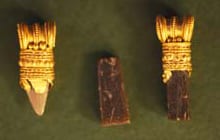SMU’s Meadows Museum honors the 15th anniversary of University Distinguished Professor of Art History P. Gregory Warden‘s groundbreaking archaeological excavation in Poggio Colla, Italy with an exhibition dedicated to the Etruscans.
“From the Temple and the Tomb: Etruscan Treasures From Tuscany” is the most comprehensive exhibition of Etruscan art ever undertaken in the United States, with more than 400 objects spanning the 9th through 2nd centuries B.C.
 |
| P. Gregory Warden at Poggio Collo |
“New Light on the Etruscans: Fifteen Years of Excavation at Poggio Colla” will offer a look into the rare and dramatic finds from this important Etruscan site.
The exhibit includes almost 100 objects from its sanctuary and from a habitation and center of ceramic production discovered in a field below its acropolis.
The excavation site spans more than 50 acres. It is the most extensive Etruscan settlement ever discovered and revealed a wealth of details about ordinary life of Etruscans, the ancestors of Rome.
Poggio Colla Field School trains students on an Etruscan site about 22 miles northeast of Florence in the scenic Mugello Valley.
The settlement on Poggio Colla spanned most of Etruscan history, from the seventh century until its destruction by the Romans at the beginning of the second century.
 |
| Students open new trenches the first week of 2008 field season. |
The first 11 seasons of excavation have revealed at least three major construction phases, including an extraordinarily rich Orientalizing-Archaic phase that includes the remains of a monumental structure on the acropolis, and two later phases when the site was turned into a fortified stronghold.
Discoveries include 2,000-year-old pendant necklaces, gold hair ornaments, rings and semi-precious stones, and silver coins. The discoveries bring to life a largely forgotten people who, among other things, built the first cities in Italy and introduced Greek culture to the Romans.
Warden, co-director of the Mugello Valley Archaeological Project, says the gold discovery was significant because the riches were not buried in tombs.
“The discovery of these gold objects in this ordinary setting is unprecedented in Etruscan archaeology,” he says.
 |
Student/staff member Rachel Julis
uncovering gold. |
Etruscan civilization thrived for hundreds of years during the first millennium B.C., before assimilation by the Romans. Little is known of them because researchers have found only scattered ruins.
The gold found at the top of a hill overlooking the Poggio Colla settlement probably was used for religious ceremonies. Like many ancient cultures, the Etruscans were obsessed with symbols and rituals, and evidence says they used such rites and totems to maintain their rigid caste structure, which existed of a tiny elite, a huge slave population and a small serf class. The items found at Poggio Colla, meticulously placed and capped with temple stones, most likely were chosen to persuade — or appease — the gods.
Both exhibitions will run from January 25 to May 17. An opening reception for SMU faculty and staff is scheduled February 5 from 4:30 p.m.-6 p.m.
The shows join the Dallas Museum of Art’s blockbuster King Tut exhibit “Tutankhamun and the Golden Age of the Pharaohs” as part of a citywide celebration of ancient civilizations of the Mediterranean.
 |
| Gold pendants |
Featured in “From the Temple and the Tomb” are an entire temple pediment — the terracotta decoration for the front of an Etruscan temple.
It will also include objects from Etruscan tombs, including sarcophagi, ash urns, guardian figures, and gold, silver, bronze, ivory and ceramic objects that were deposited in the tombs of the wealthy.
Also featured are several pieces of gold jewelry, created using techniques so advanced that they are difficult to reproduce today.
“From the Temple and the Tomb” is organized by the Meadows Museum in association with the Florence Archaeological Museum, Italy, the Italian Ministry of Culture, the Soprintendenza of Archaeology for Tuscany, and Centro Promozioni e Servizidi Arezzo. It was funded by a gift from The Meadows Foundation.
Related links:
WSJ: Etruscan treasures from Tuscany
USAToday: Ancient Etruscan treasures go on display in Dallas
Bryn Mawr Classical Review: Review of the exhibit
P. Gregory Warden
Meadows: “From the Temple and the Tomb”
Meadows: “New Light on the Etruscans”
Poggio Colla Field School
Student research projects
2008 field school student diaries
2008 field school directors’ diaries
Mugello Valley Region
 Wetherington’s research interests include population genetics, human paleontology, science pedagogy and the historical archaeology of the U.S. Southwest.
Wetherington’s research interests include population genetics, human paleontology, science pedagogy and the historical archaeology of the U.S. Southwest.



